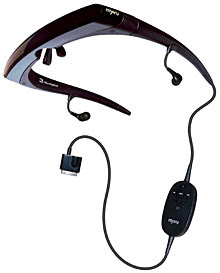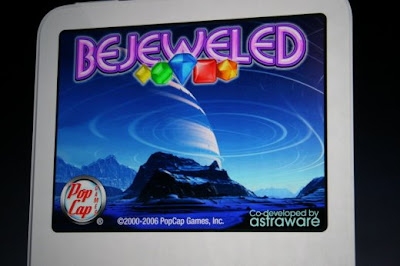Yeah, we know we're a little late with this one, but we see the
iPod touch as a pretty major turning point for Apple's iPod line; when it was
announced, we finally thought we'd found an iPod we could really get behind. For years technology enthusiasts pondered the possibility of an Apple-made widescreen, WiFi-enabled portable media device, and they finally did just that -- even throwing in a few things that, prior to the iPhone, we might not have expected, like a full-fledged web browser, internet video player (YouTube), multi-touch interface, etc. But after playing with the touch for a few days, it's become pretty clear that Steve was right when he declared that the iPhone is still the best iPod. Read on to find out why.
Late last year. iPods had fallen into a rut: the features were stale, the form factor of the flagship device basically stopped progressing, and it started to seem like Apple didn't care or understand where portable media players were headed -- or at least didn't seem to realize what such devices were capable of. So it came as no surprise that as soon as the iPhone was announced, people began demanding that same device, sans phone. And why not? Not
everyone hates their cellphone, or wants to switch to AT&T, or lives in America (or select countries in Europe) -- and from a media player standpoint, the iPhone made the iPod technologically respectable again. Only a handful of other devices, like the
Archos 604 WiFi, come equipped with that specific bundle of features (web browser, touchscreen, and WiFi).
Fortunately for that rather sizable group of potential buyers waiting for the phoneless iPhone, it was clear that Apple had invested an enormous amount of effort (and money) into creating its mobile OS X platform, and that all those development bucks weren't going to live on in only one product -- especially not a device that is ultimately beholden to deals with cellphone carriers. So the iPhone without the phone -- the WiFi-enabled widescreen iPod -- finally started to seem more like an eventuality than some distant hope. When it was announced a couple of weeks ago, the surprise was less that Apple had been working on this device after all, and more the myriad iPhone features unexpectedly absent. We'll get to that shortly.
MediaThankfully, as far as media playback goes, all the best stuff from the iPhone made the cut in the touch. It shares the same audio, video, and photo apps as the iPhone, which is a good thing since we still love the new Apple mobile media interface every bit as much as we did when we first reviewed the iPhone. The
iTunes WiFi Music Store works exactly as advertised; search is fast, sampling tracks and downloads are easy, and syncing tracks back to your host computer is effortless. Apple really nailed this. To date, most over the air music downloads on a portable media devices have been tedious, if not completely impractical.
Also unchanged are our primary complaints about said media playback, the same complaints we've had about the iPod for years: we don't like managing our media through iTunes, and we don't like being limited only to those few codecs Apple supports (AAC, MP3, H.264, and MPEG-4). In fact, if Apple gave us greater codec support (or even just the option to add additional codecs ourselves) and mass storage support for drag and drop while adding media, we'd probably be able to overlook the other, smaller things that ail us about iPods.
SoftwareSince the touch is an iPhone at its heart --
really -- comparisons on the software end of business were immediate and inevitable. We're going to assume you're at least casually familiar with the touch's progenitor, but if you didn't read over our
iPhone review or haven't much used one yourself, we're happy to say the touch remains a rock solid device on the software end. We experienced far fewer crashes now than we did with the v1.0 iPhone firmware; the rest of the interface is just as responsive and reliable.
Apple has also since made a number of improvements to the touch which have yet to carry over to the iPhone. (We're expecting the iPhone to be brought to parity with the touch in its
next firmware update, due in the next week or so.) One major annoyance, about which we took umbrage in our iPhone review, is that periods are unnecessarily difficult to type. No longer: the touch takes the BlackBerry approach, where pressing the space bar twice types a period automatically. This is a godsend.
Also improved: many of the clicks, chirps, and other system sounds have been tweaked, most often with the result of being slightly less grating than the noises of the iPhone. And, of course, the addition of international support in menus and keyboards means you don't have to be a US American to use the thing.
But it isn't what's
on the touch that caused us to sit up and take notice so much as what's
not on it. The iPhone's suite of apps set certain expectations for what the touch should include. Granted, we understand why the iPhone's mobile email app was omitted from the touch. While we still would have liked to have the option to email over WiFi, its intended purpose is as a portable media player, not a mobile communicator, so we can follow that line of thought. But why leave out its notes, weather, stocks, and Google maps apps? We know the portable doesn't include the same constant connectivity as the iPhone has with EDGE, but it's not like downloading music over the iTunes WiFi Music Store is a practical application in ways that checking for weather, or jotting down a quick note are not. The touch is still a connected portable device, after all, and what we see is Apple mimicking the limited feature set of the old, stale iPod line instead of fully realizing the touch's potential.


And let's not forget the touch calendar controversy. Why allow users to indulge in some PIM basics, like editing and creating new contacts, while not others, like editing or adding new calendar appointments? When we
confirmed that Apple had indeed dropped calendar editing from the touch, we were floored. Not even because it's that essential a function, but because we can't possibly fathom why anyone in Cupertino thought to take something of value, however small, away from for no apparent reason.
For a company that continually emphasizes its software as being the core of what drives great consumer electronics, we just can't understand why Apple chose curb the touch's capabilities right at the outset.
HardwareWith the touch, Apple's hardware is, as usual, striking when compared with many of its competitors. Ever so slightly wider (about 1mm) and significantly thinner (8mm, which is no small feat) than the iPhone, the touch has far harder, sharper edges on its facade, and a sloping, almost difficult to grip rear. It even manages to leverage that space with a large enough battery to put out more than its advertised 5 hours of video playback -- we got about 5.5 - 6+ hours. But despite its impressive thinness, after the last few months of using the far more functional iPhone, the touch left us in want. It may be the ideal size for a device of this kind, but it omits many of the simple hardware niceties we've grown used to in the iPhone.
Hardware volume controls were highest on the list of things we miss. We could just as easily live without a mute switch on a media player, but losing the hard volume buttons is rather disappointing. Granted, Apple has made it easier to get to the media controls and volume when the device is in sleep mode; just press the home button three times (once to wake, two more times to bring up media controls without unlocking it). But what's wrong with a real volume switch, too? With no hardware controls, doing something as frequent and essential as changing the volume necessitates removing the device from your pocket. Furthermore, without hard volume buttons, you can't adjust the volume at all while playing music in landscape (i.e. Cover Flow mode). This is pretty basic stuff that drives us up the wall.

Also missing -- and missed: an external speaker. Yeah, we know not every media player has one, and it probably would have added some bulk to a device so slim as the touch. But sharing samples of songs, a bit of video, or -- duh -- YouTube now instantly necessitates friends adventurous enough to use your funky headphones each taking a turn watching Chocolate Rain or the Hipster Olympics. We know in the long run it's a relatively minor thing, but it's still disappointing.

But that's not all. While we appreciate the aesthetic sacrifice Apple made in in adding a proper WiFi antenna to the touch, the odd, asymmetric black corner on the rear looks off and misplaced. We wish Apple have just placed the antenna behind the touch's face, or possibly along the top or bottom of the unit, where its sleep / wake button or headphone jack is. It's a relatively minor aesthetic nitpick, we know, but Apple obviously holds its hardware design in the highest regard, and to us the antenna seems uncharacteristically out of place for an iPod product too pristine to even have hardware volume controls.
Then there's the matter of the display. Ours happened to be one of the
"small number" of touch units with the faulty screens. It's difficult to capture in a photograph or even explain in text (so far the best shots we've seen came from
Apple-Touch), but the result is dark shades -- especially black tones -- look almost inverted. At very least it's distracting, and at worst it makes some darker video almost unwatchable. We hope Apple gets these units fixed on the double, because for us this janky screen teeters on the edge of a return-your-unit-forever dealbreaker.
And then, finally, there's the shiny chrome back side, which is just as easy as ever to keep pristine and unmarred, provided you store your iPod in a vacuum or cover it in armor. We still don't get this. Yes, people like shiny gadgets, but the glee of that first five seconds of
ooh pretty hardly outweighs the lifetime of fingerprints and scratches that the iPod's rear mirror finish accumulates. We thought Apple had learned its lesson when it gave the iPhone a matte aluminum back side. Guess not. We can't be alone in thinking chrome doesn't patina like an old pair of jeans. To us it just seems to look worse with time.
Wrap-upIt's hard to argue that there isn't beauty in simplicity, especially when it comes to consumer electronics. But there's such thing as
too simple -- and sometimes too simple can turn into crippled. Most of our complaints about the touch have to do with what it lacks -- not in general, but when compared its big brother, the iPhone. Had the iPod touch come out first, the lack of a hardware volume switch, integrated speaker, and all those apps might have been perfectly passable, but now the expectations have been set, and we can't see how taking things away from users can possibly add value. Everyone in this industry is trying to give their customers more, but with the iPod touch Apple gave its customers
less in what should have been the best iPhone alternative on the market. This time around, in Apple's obsession to edit, they managed to leave some of the best stuff on the cutting room floor.




















